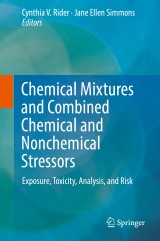Details

Chemical Mixtures and Combined Chemical and Nonchemical Stressors
Exposure, Toxicity, Analysis, and Risk|
213,99 € |
|
| Verlag: | Springer |
| Format: | |
| Veröffentl.: | 16.02.2018 |
| ISBN/EAN: | 9783319562346 |
| Sprache: | englisch |
Dieses eBook enthält ein Wasserzeichen.
Beschreibungen
In this book, both basic and advanced concepts are discussed for considering mixtures from initial exposure characterization through evaluation of risk associated with combined exposures. This book will provide an introduction to key issues and multiple options for evaluating both the toxicity of mixtures as well as the risk associated with exposure to mixtures. Additionally, promising tools adapted from other disciplines will be discussed in the context of mixtures toxicology and risk assessment. Finally, the discussion will move beyond chemical mixtures to address incorporating non-chemical stressors into toxicity studies and cumulative risk assessments. Although exposure to multiple chemical and non-chemical stressors is the rule, not the exception, consideration of mixtures in toxicology and risk assessment continues to be a significant challenge. This book will be an essential resource for researchers and professionals in the fields of toxicology, epidemiology, exposure science, risk assessment, and statistics.
Introduction.- Combined exposures.-Measuring combined exposures.- Modeling complex exposures.-Prioritizing mixtures for study.- Environment-Wide Association Studies.- Biogeographical analysis of chemical co-occurrence.- Combining exposure and toxicity information to develop logical groupings for assessment.- Maximum Cumulative Ratio for deciding when to assess mixtures .- Establishing the “no interaction” baseline.- Dose addition models .- Response addition.- Integrated addition.- Mixture statistics – comparing predicted to observed.- Cumulative Risk Assessment.- Deciding which approach to use.- Component-based approaches.- Sufficient similarity of whole mixtures.- Other whole mixtures approaches .- Assessing interactions.- Likelihood and examples of chemical interactions.- PBPK modeling of chemical interactions.- Adding interactions to cumulative risk assessment.- Consideration of nonchemical stressors.- Toxicity and interactions of physical and chemical stressors.- Psychosocial and chemical stressors.- Adding nonchemical stressors to cumulative risk assessments.- Disease-based risk assessment.- Community-based risk assessment.
<p></p><p>Dr. Cynthia Rider is a toxicologist with the National Toxicology Program, National Institute of Environmental Health Sciences, where she has been actively involved in mixtures research including work with polycyclic aromatic hydrocarbons and herbal products. She received her B.S. from Tulane University and her Ph.D. from North Carolina State University in Environmental Toxicology. She completed post-doctoral training in the Reproductive Toxicology Branch of the National Health and Environmental Effects Research Laboratory, U. S. Environmental Protection Agency (EPA) and the Nicholas School of the Environment at Duke University. Dr. Rider has been an active member of the mixtures community through reviewing papers, serving on an EPA panel on cumulative risk assessment of phthalates, and developing mixtures-related scientific program proposals for Society of Toxicology annual meetings. </p><p>Jane Ellen Simmons is Chief of the Pharmacokinetics Branch, National Health and Environmental Effects Research Laboratory, US EPA. She received an MSPH in Environmental Management and Protection and a PhD in Toxicology from the Department of Environmental Sciences and Engineering, School of Public Health, University of North Carolina at Chapel Hill. Her research focus areas include: models, methods and approaches for both defined mixtures and environmentally realistic complex mixtures; integrating chemical and toxicological evaluations of chemical mixtures; and much more. She is a Diplomate of the American Board of Toxicology. She co-chaired the International Toxicology of Mixtures Conference and has served on the HiWate Science Advisory Board, on review panels for the Food and Drug Administration and North Carolina State University and Advisor to the US EPA RTP Chapter of the National Training Leadership Organization. Dr. Simmons has also authored more than 90 peer-reviewed journal articles and 15 book chapters and reports.</p><p></p>
<div><p>Exposure to multiple chemical and nonchemical stressors is the rule, not the exception. Nevertheless, it continues to be a significant challenge in toxicology and risk assessment to thoroughly take mixtures into account. In this book, both basic and advanced concepts for considering mixtures are discussed, from initial-exposure characterization through the evaluation of risk associated with combined exposures. Several chapters also examine the adoption of promising tools from other disciplines. Looking beyond chemical mixtures, the discussion also addresses incorporating nonchemical stressors into toxicity studies and cumulative-risk assessments. </p> This “excellent” volume—as described by Linda S. Birnbaum, Director of the National Institute of Environmental Health Sciences and the National Toxicology Program, in her foreword to the book—forms “a comprehensive picture of the current state of mixtures science.” With contributions from a host of established experts, <i>Chemical Mixtures and Combined Chemical and Nonchemical Stressors: Exposure, Toxicity, Analysis, and Risk </i>is an essential text for mixtures researchers in the fields of toxicology, epidemiology, exposure science, risk assessment, and statistics. Both seasoned mixtures researchers and those new to the field will appreciate the clear explanations of mixtures concepts as well as the comprehensive presentation of available tools for predicting mixture effects and estimating risk from combined exposures. This volume also serves as a useful reference book for students. </div><p></p>
<p>Presents the available mixture models in a clear and simple way, allowing readers to apply tools to their own research</p><p>Includes novel methods for prioritizing mixtures for study</p><p>Surveys what is known about interactions between chemical and non-chemical stressors and discusses various approaches for including non-chemical stressors in cumulative risk assessments</p>
Diese Produkte könnten Sie auch interessieren:

Apoptotic Pathways as Targets for Novel Therapies in Cancer and Other Diseases

von: Marek Los, Spencer B. Gibson

149,79 €















